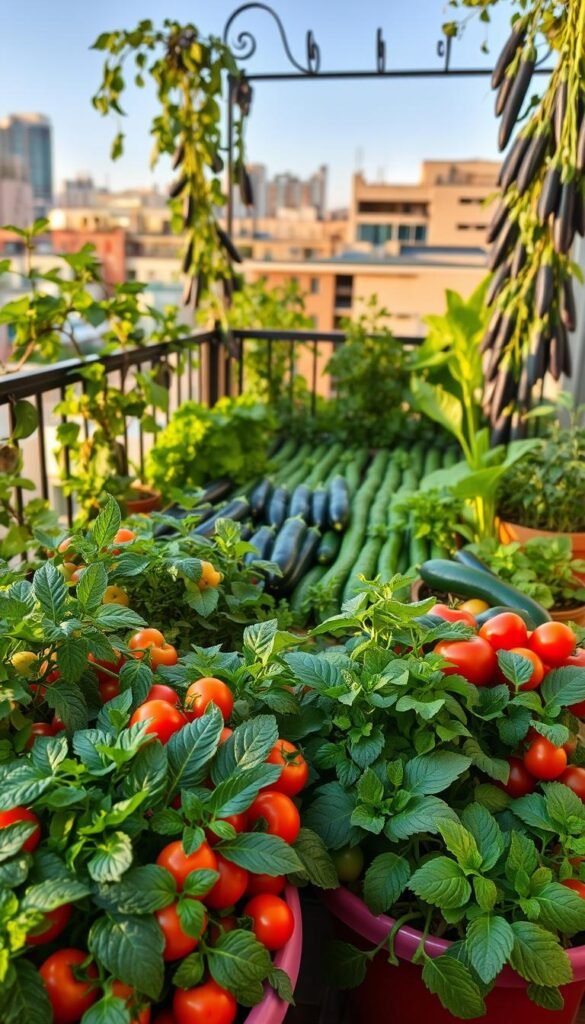Imagine stepping outside to pluck fresh ingredients for tonight’s dinner – right from your own balcony. You don’t need sprawling yards to enjoy homegrown produce. With smart container choices and sunlight, even tight spaces can yield flavorful results.
This guide focuses on plants that thrive in confined areas, perfect for urban dwellers. Whether you’re nurturing herbs in window boxes or tomatoes in fabric pots, success starts with selecting space-efficient varieties. Ryan McEnany of Bailey Nurseries confirms: “Many vegetables adapt beautifully to containers when given proper care.”
We’ll explore low-maintenance options that deliver big flavors without demanding square footage. From crisp lettuces to vibrant peppers, each pick prioritizes adaptability and high yields. You’ll also learn about sunlight needs, watering tricks, and pest management tailored for elevated growing spaces.
Ready to turn your balcony into a green oasis? Let’s dig into the essentials for creating a thriving edible garden – no backyard required.
Key Takeaways
- Container gardening maximizes limited areas like patios or railings
- Choose vegetables bred for compact growth and shallow roots
- Even beginners achieve success with proper plant selection
- Expert-approved techniques ensure healthy balcony harvests
- Freshly picked produce enhances meals with superior taste
Starting Your Balcony Garden: Container Gardening Basics
Container gardening turns even the smallest outdoor area into a productive green haven. Whether you’re working with a sunny ledge or a shaded corner, flexible containers let you customize your setup. Let’s break down the essentials to get your edible oasis thriving.
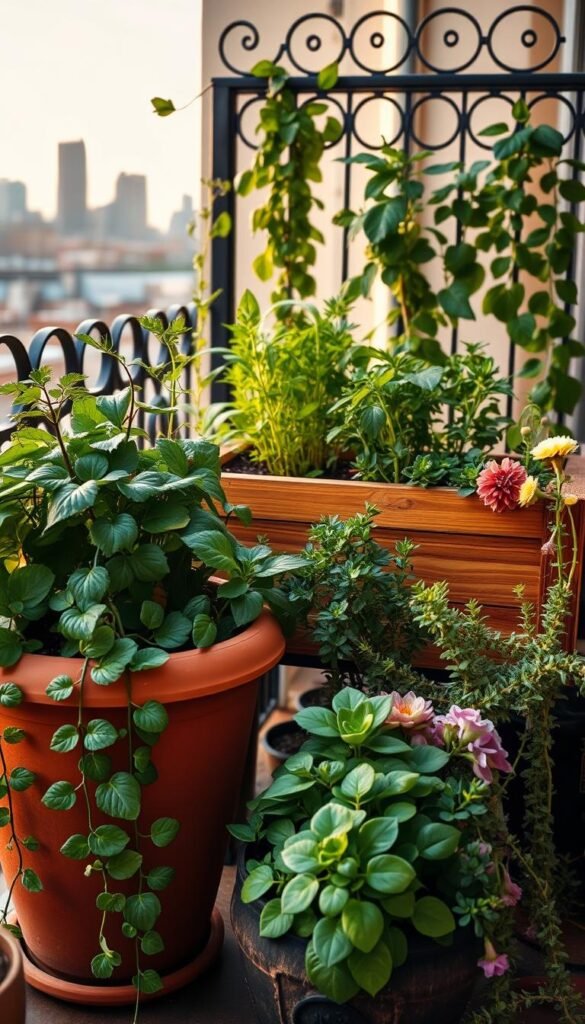
Why Containers Work Wonders
Pots and planters give you complete control over soil quality and sunlight exposure. Unlike traditional gardens, you can shuffle plants to chase light or shield them from harsh weather. “Proper drainage is non-negotiable,” says Ryan McEnany. “Roots drown in soggy soil, so always choose containers with holes.”
Herbs like basil and mint thrive in these conditions. Their shallow roots adapt well to confined spaces, and they need less frequent watering than many veggies. Plus, moving pots indoors during frost extends your growing season.
Tools That Make Life Easier
You don’t need a shed full of gear. Start with these basics:
- Trowel: Perfect for transplanting seedlings
- Watering can with a narrow spout: Targets roots without splashing leaves
- Pruners: Keeps plants compact and productive
Pair your tools with lightweight, durable pots. Fabric planters promote air circulation, while ceramic adds style. Arrange taller plants at the back and trailing varieties like cherry tomatoes near edges to maximize space. Rotate pots weekly for even growth, and watch your balcony garden flourish!
Top 10 Vegetables for Small Space & Balcony Gardens
Your patio or windowsill can burst with flavor-packed options designed for vertical growth and shallow roots. Let’s explore the stars of container gardening – plants that deliver big yields without sprawling.
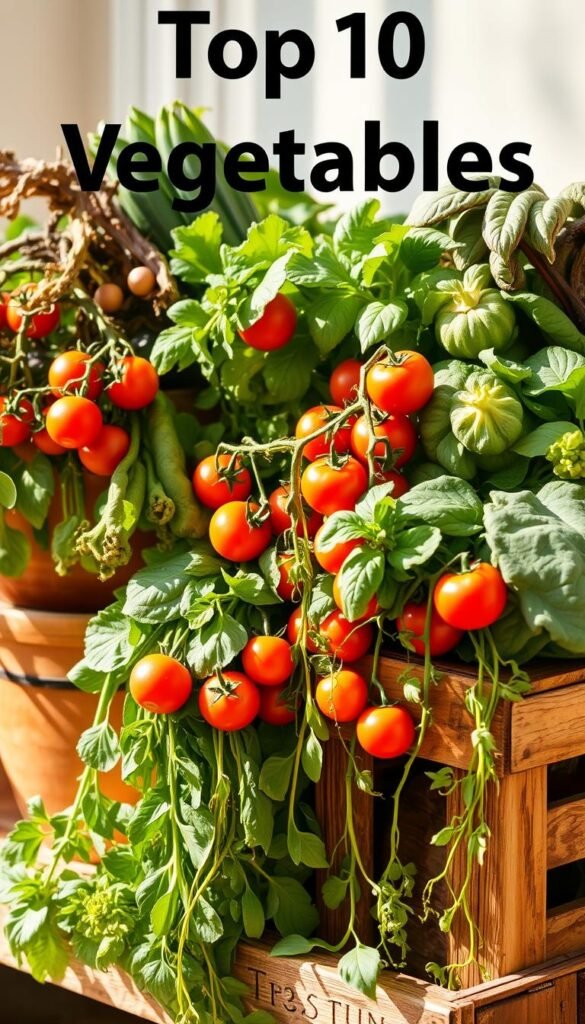
| Plant | Container Size | Key Benefit |
|---|---|---|
| ‘Pizza My Heart’ peppers | 5-gallon | Sweet, blocky fruits all summer |
| Bush slicer cucumbers | 12″ deep | Crisp yields without vines |
| Cherry tomatoes | 10″ diameter | Continuous snacking harvest |
| Rainbow chard | 8″ wide | Colorful leaves & stems |
| French breakfast radishes | 6″ depth | Ready in 25 days |
Compact basil varieties like ‘Spicy Globe’ form neat mounds perfect for windowsills. Their aromatic leaves thrive in 8-inch pots with afternoon shade. For vertical interest, try ‘Tumbling Tom’ tomatoes cascading from hanging planters.
Prevent rootbound plants by choosing containers at least 2 inches wider than mature root systems. Fabric grow bags work wonders for peppers and eggplants, allowing air pruning. Rotate pots weekly so all sides get equal light exposure.
These space-savvy choices prove you don’t need acreage for fresh flavors. With smart variety selection and proper care, your elevated garden becomes a nonstop produce aisle – just steps from your kitchen.
Creating Optimal Growing Conditions: Sunlight, Soil, and Watering
Your balcony garden thrives when three elements align: sunlight, soil quality, and consistent watering. Think of these as your plants’ daily bread – get them right, and you’ll see explosive growth.

Understanding Sunlight Needs for Your Balcony
Most veggies need 6-8 hours of direct sun daily. Track your space’s light patterns with a free phone app like Sun Seeker or simply observe shadows every hour. Leafy greens tolerate partial shade, while tomatoes demand full southern exposure.
| Plant Type | Minimum Sun | Adjustment Tip |
|---|---|---|
| Peppers & Tomatoes | 8 hours | Use reflective surfaces |
| Herbs & Lettuce | 4-6 hours | Rotate pots morning/afternoon |
| Root Vegetables | 6 hours | Elevate containers for better angles |
Selecting the Best Soil Mix and Fertilizer
Grab potting mixes labeled for containers – they retain moisture without drowning roots. Ryan McEnany recommends: “Mix in 25% compost for slow-release nutrients. Your plants will thank you with bigger harvests.”
Water when the top inch of soil feels dry. Always choose pots with drainage holes, and add a layer of gravel beneath the soil. For hot areas, try self-watering planters to prevent midday wilting.
Pro tip: Mark watering days on your calendar. Consistency prevents blossom-end rot in tomatoes and bitter flavors in greens. Experiment with moisture meters or the classic finger test to find your rhythm.
Choosing the Right Containers and Tools
The right containers can make or break your edible oasis. Start by matching pot sizes to your plants’ needs. Shallow-rooted herbs thrive in 6-inch-deep pots, while tomatoes demand at least 12 inches for strong root development.
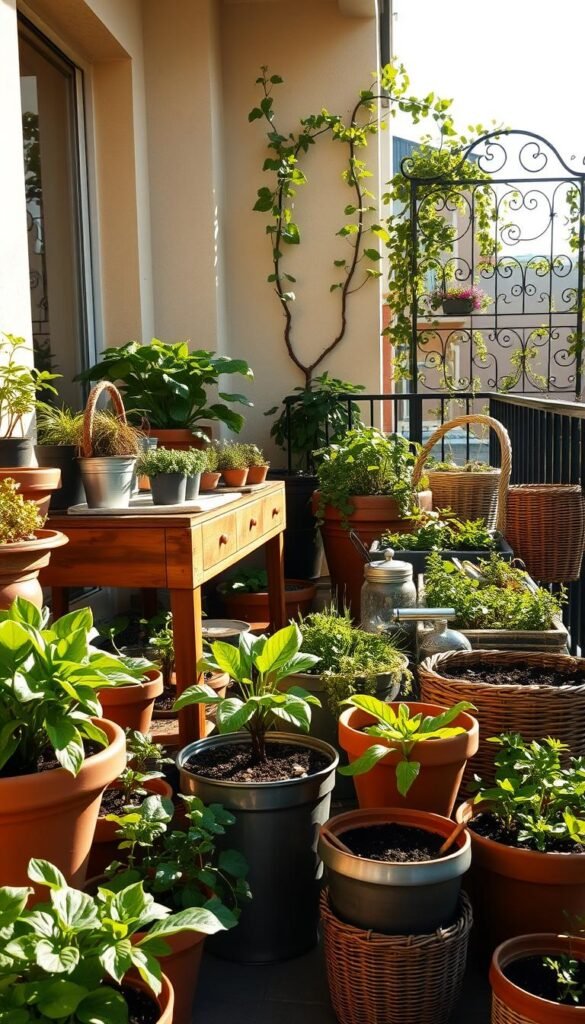
Tips for Container Selection and Setup
Fabric pots excel at preventing waterlogging through breathable walls. Plastic containers are lightweight and budget-friendly, while ceramic adds elegance (though they’re heavier). Whatever you choose, drainage holes are non-negotiable – drill extras if needed.
Consider these size guidelines:
- Leafy greens: 8-10″ wide pots
- Peppers: 5-gallon buckets
- Carrots: 12″-deep planters
Pair your containers with three essential tools: a hand trowel for transplanting, sharp pruners for trimming, and a long-spout watering can for precision. For extra efficiency, try self-watering pots if your container gardening space gets afternoon sun.
Arrange pots strategically – cluster taller plants at the back and let trailing varieties spill over railings. Rotate containers weekly so all sides get equal light. With smart choices, your setup becomes both functional and Instagram-worthy!
Incorporating Herbs, Fruits, and Edible Flowers
Transform your balcony into a vibrant mix of flavors and colors by blending practical herbs with showstopping blooms. These additions boost your cooking game while creating visual interest – think of it as a living spice rack that doubles as decor.
Favorite Herbs for Enhanced Flavors
Mint and basil thrive in small pots, offering fresh leaves for teas, pastas, or summer drinks. Rosemary’s woody stems add depth to roasted veggies, and its compact growth fits narrow spaces. For quick results, try cherry-scented varieties like ‘Sweet Dani’ basil – they’re perfect for snipping into salads or garnishing dishes.
Growing Compact Fruits and Edible Flowers in Pots
Strawberries cascade beautifully from hanging planters, while dwarf lemon trees in 15-gallon containers yield tart fruits year-round. Pair them with edible blooms like nasturtiums – their peppery petals jazz up edible landscaping designs. Pansies and calendula attract pollinators while brightening your space.
Water herbs when soil feels dry an inch down. Use balanced liquid fertilizer every 3 weeks. For fruits, choose pots twice their root size and add mulch to retain moisture. Rotate planters weekly so all sides get equal sun exposure.
Mix herbs with veggies like tomatoes or peppers – basil repels pests while enhancing their flavor. Keep trailing plants near railings and upright varieties in corners. With smart pairings, your balcony becomes a multi-layered feast for the senses!
Maximizing Space with Smart Garden Layout and Plant Pairing
Elevate your harvest by thinking beyond ground level. Clever arrangements let you grow more food in the same square footage while creating visual appeal. It’s like solving a puzzle where every piece – from wall-mounted planters to strategic pairings – boosts productivity.
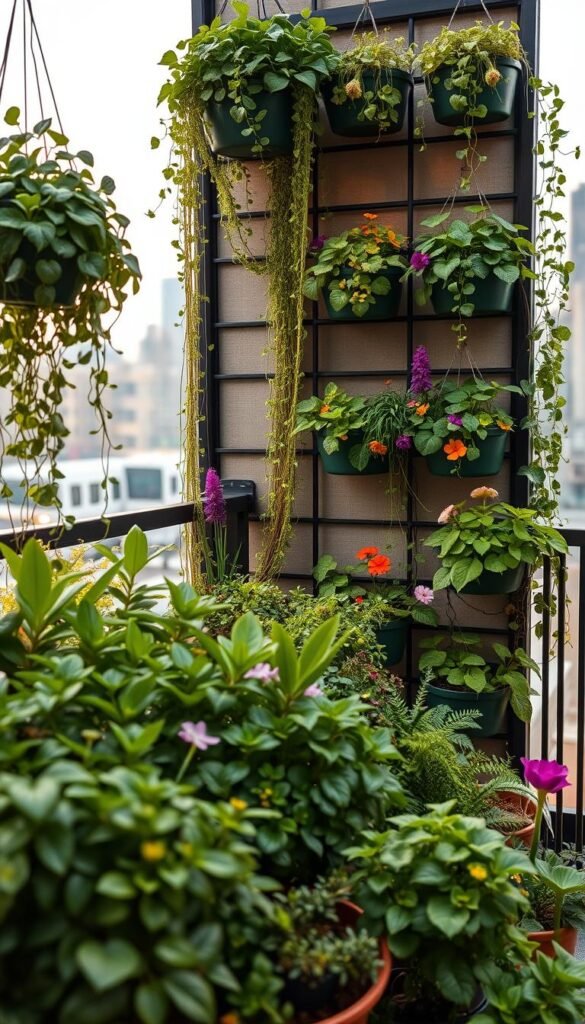
Sky-High Growing Solutions
Turn blank walls and railings into edible tapestries. Install wire grids for peas or cucumbers to climb. Hanging baskets work wonders for cherry tomatoes and trailing herbs like oregano. For tight corners, stack tiered planters with leafy greens below and vining beans above.
Try these space-saving combos:
| Support Structure | Ideal Plants | Summer Care Tip |
|---|---|---|
| Trellis | Pole beans, mini cucumbers | Twist vines clockwise weekly |
| Hanging planter | Strawberries, nasturtiums | Water daily in afternoon heat |
| Wall pocket | Lettuce, spinach | Rotate every 3 days |
Power Pairings for Healthier Plants
Some plants thrive together like best friends. Basil repels pests from tomatoes, while marigolds protect peppers. Avoid grouping same-family veggies – like potatoes near tomatoes – to prevent disease spread.
Arrange containers so tall plants don’t shade shorter ones. Cluster mint and thyme near seating areas where their scent can waft through summer breezes. Leave 6 inches between pots for airflow, and watch your grow balcony transform into a lush, layered paradise!
Tips for Overcoming Common Gardening Challenges
Even the most carefully tended plants face hurdles. But with quick action and smart strategies, you’ll keep your edible oasis thriving. Let’s tackle solutions for two frequent issues – uninvited pests and soggy soil.
Outsmarting Unwanted Visitors
Spot holes in leaves or sticky residue? Aphids and spider mites love crowded plants. Blast them off with water or apply neem oil weekly. For tomato hornworms, handpick at dawn when they’re most visible.
| Pest | Favorite Plants | Natural Fix |
|---|---|---|
| Whiteflies | Peppers, herbs | Yellow sticky traps |
| Slugs | Lettuce, radishes | Copper tape barriers |
| Powdery mildew | Squash, cucumbers | Baking soda spray |
Rotate crops yearly to break disease cycles. Remove infected leaves immediately to protect your harvest’s flavor. Ryan McEnany advises: “Prevention beats cure – inspect plants every 3 days during peak growth.”
Water Wisdom for Healthy Roots
Yellow leaves and wilted stems often signal overwatering. Make sure containers drain completely – elevate pots on bricks if needed. For tomatoes, let soil dry slightly between waterings to intensify fruit taste.
Try this simple test:
- Insert finger up to second knuckle
- If soil sticks, wait another day
- Add perlite to mixes for better airflow
Self-watering pots help maintain perfect moisture for radishes and leafy greens. Remember: consistent care leads to plump veggies and proud plant parents. Your patio paradise will reward patience with baskets full of sun-ripened goodness!
Conclusion
Your journey to fresh flavors begins with a single pot. Container gardening unlocks endless possibilities, letting you cultivate juicy tomatoes, crisp cucumbers, and aromatic basil even in tight corners. With smart choices like breathable pots and nutrient-rich soil, you’ll create a thriving edible retreat.
Remember: match containers to your plants’ needs. Herbs like mint flourish in shallow pots, while peppers demand deeper roots. Pair vertical trellises with compact beans or cherry tomatoes to multiply yields. Companion planting – like basil near lettuce – naturally deters pests while boosting flavor.
Struggles like overwatering or aphids? Check soil moisture before reaching for the watering can. Use neem oil sprays for bugs and rotate crops yearly. Every challenge solved makes your green space more resilient.
Now’s the time to reimagine your balcony. Whether you’re growing peppery radishes for salads or strawberries for summer desserts, each harvest celebrates your creativity. Grab a pot, pick your favorite seeds, and taste the pride of homegrown goodness. Your flavor-packed oasis awaits – let’s get growing!

